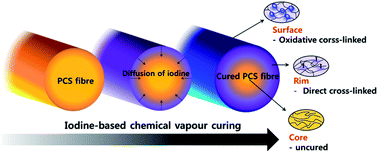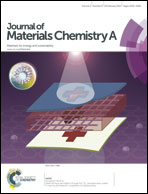Low-temperature chemical vapour curing using iodine for fabrication of continuous silicon carbide fibres from low-molecular-weight polycarbosilane
Abstract
In order to manufacture fine and continuous silicon carbide (SiC) fibres from low-molecular-weight polycarbosilane (PCS), a new chemical vapour curing process based on the use of iodine was developed. Its main advantages are short processing-time (∼1 h) and low processing-temperature (∼100 °C). The underlying curing mechanism was investigated by performing TG-DTA, GC-MS, solid-state NMR, FTIR, FE-EPMA, ESR, elemental analysis, and XRD. The results indicate that the curing reaction occurs upon diffusion of iodine into the PCS, where iodine plays the critical role of accelerating the cleavage of Si–H (mainly), Si–Si, and C–H bonds. This cleavage coincides with recombination to form cross-linked networks of –Si–C– and –C![[double bond, length as m-dash]](https://www.rsc.org/images/entities/char_e001.gif) C–. The by-products were identified as oligomeric silanes, iodomethane, and aromatics. When the curing is conducted in air, the surface region in contact with oxygen is heavily oxidized to form a Si–O–Si network that is localized on the surface.
C–. The by-products were identified as oligomeric silanes, iodomethane, and aromatics. When the curing is conducted in air, the surface region in contact with oxygen is heavily oxidized to form a Si–O–Si network that is localized on the surface.


 Please wait while we load your content...
Please wait while we load your content...